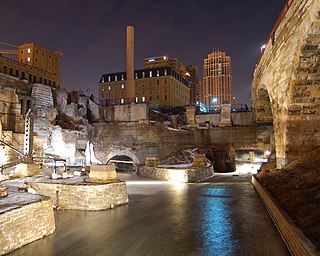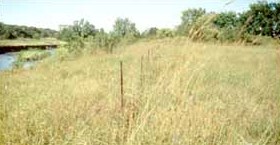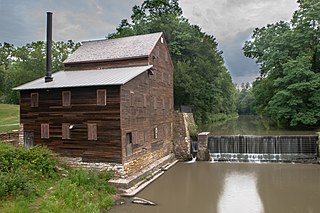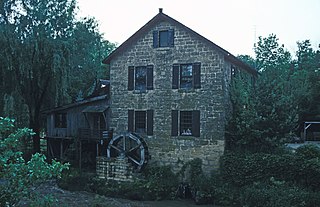Related Research Articles

This is a list of properties and historic districts in Iowa that are listed on the National Register of Historic Places. There are listings in all of Iowa's 99 counties, adding up to over 2,300 total.

This is a list of properties and districts in Indiana that are listed on the National Register of Historic Places. There are over 1,900 in total. Of these, 39 are National Historic Landmarks. Each of Indiana's 92 counties has at least two listings.

This is a list of the National Register of Historic Places listings in Cheboygan County, Michigan.

This is a list of properties and historic districts in Kentucky that are listed on the National Register of Historic Places. There are listings in all of Kentucky's 120 counties.

Mill Ruins Park is a park in downtown Minneapolis, Minnesota, United States, standing on the west side of Saint Anthony Falls on the Mississippi River. The park interprets the history of flour milling in Minneapolis and shows the ruins of several flour mills that were abandoned.

Indian Village State Preserve, or the Wittrock Indian Village State Preserve, is a state archaeological preserve near Sutherland, Iowa. The 6-acre (2.4 ha) property preserves the Indian Village Site (13OB4), a prehistoric fortified village of the Mill Creek culture. It was declared a National Historic Landmark in 1964, and made a state preserve in 1968. It is located east of Sutherland, south of 455th Street and west of Yellow Avenue. Access to the preserve requires crossing private land.
The Phipps Site (13CK21) is a Late Prehistoric Mill Creek culture archaeological site near Cherokee in Cherokee County, Iowa, United States. Its principal feature, a refuse midden, has yielded important information on the formation of middens in the region. The site was declared a National Historic Landmark in 1964.

The Dillard Mill State Historic Site is a privately owned, state-administered property on Huzzah Creek in Crawford County, Missouri, that preserves a water-powered gristmill. The 132-acre (53 ha) site has been operated as a state historic site by the Missouri Department of Natural Resources under a lease agreement with the L-A-D Foundation since 1975. The site was listed on the National Register of Historic Places in 2015.

The Chan-Ya-Ta Site (13BV1) is a Late Prehistoric village in Buena Vista County, Iowa, United States, in which Native Americans lived in large earthlodge structures surrounded by a fortified ditch. The site is part of the Mill Creek Culture, which flourished in northwest Iowa 1100-1200 CE.

This is a list of the National Register of Historic Places listings in Clayton County, Iowa.

Pony Creek Park is a park in Oak Township, Mills County, Iowa, United States, northwest of Glenwood. Centered around the 83-acre (34 ha) Pony Creek Lake, it offers boating, picnicking, and fishing areas. Other features of the park include woods, a camping area, virgin prairie, and a viewing area for the local loess topography.

The Fremont Mill Bridge near Anamosa, Iowa was built in 1873. Its superstructure was designed and built by Massillon Iron Bridge Company and its foundations were built by James Milne. It is a wrought iron bowstring through arch bridge.

Pine Creek Gristmill is a historic building located in Wildcat Den State Park in Muscatine County, Iowa, United States. The building was listed on the National Register of Historic Places in 1979.

The Pine Mill Bridge is an historic structure located in Wildcat Den State Park in rural Muscatine County, Iowa, United States. It was built in 1878 near the Pine Creek Gristmill, the only place in Iowa where a mill and bridge combination remains in place. The bridge was listed on the National Register of Historic Places in 1998 as a part of the Highway Bridges of Iowa MPS.

This is a list of the National Register of Historic Places listings in Buena Vista County, Iowa.

Mill Creek Bridge is a historic structure located in a rural area north of Clarence, Iowa, United States.The Cedar Bluff Bridge over the Cedar River was the first all-iron span built in Cedar County in 1877. Four more iron spans were built later that year, as were several others over the years before this bridge was completed in 1889. It is the only one of those bridges left, and one of the oldest pony truss bridges in the state of Iowa. Citizens in Dayton Township petitioned the Cedar County Board of Supervisors in June 1888 for the bridge over Mill Creek. The supervisors contracted with Ward and Keepers of Clinton, Iowa to design and build the bridge. The 58-foot (1,800 cm) span was built on concrete-filled iron cylinder piers, with timber stringer approach spans. Over the years sub-structural alterations have been made to the bridge. It has subsequently been abandoned and its deck is in a deteriorating condition. The bridge was listed on the National Register of Historic Places in 1998.

Seneca Williams Mill is a historic building located just outside of Maquoketa, Iowa, United States. Originally known as Oakland Mill, it was built by Joseph Willey in 1867. The 2½-story stone building has a partial basement and is capped with a gable roof. A water-powered turbine, still extant, supplied the power to operate the mill. The location of the mill race can still be seen on the east side of the property, and permanents of the damn remain in Prairie Creek. None of the mill workings remain on the inside. Willey sold the mill to Seneca Williams in 1867, and he operated in until 1904. The building was converted into a barn in 1920. The building was listed on the National Register of Historic Places in 1976. Wildlife artist Patrick J. Costello used the old mill as a residence and studio from 1979 to 2006. His daughter Tracy Costello Taylor has operated it since as a reception hall.

Valley Mills is a historic building located east of Garnavillo, Iowa, United States. This is one of at least four mills that was located on Buck Creek in the 19th century. They included both grist and lumber mills. The first mill located on this site was a lumber mill built in 1850. A change in ownership and an expansion of the business led to the construction of this grist mill three years later. The two-story structure is composed of roughly dressed limestone, has an exposed basement, and is capped with a gable roof. It was built for B. E. Schroeder and J. H. Kueuzel, who owned the mill until 1867. Kueuzel then held sole ownership into the 1880s. The building was listed on the National Register of Historic Places in 1976.

The Fish Creek Bridge is a historic structure that was originally located east of Salem, Iowa, United States. The span carried Hickory Road over Fish Creek for 50 feet (15 m). It is a small-scale, wrought-iron bridge that the Henry County Board of Supervisors bought from the George E. King Bridge Company of Des Moines in 1893 for $410.80. It was believed to have been fabricated by their parent company, King Iron Bridge Company of Cleveland, and assembled by local laborers. Its historical significance derived from its being an uncommon variant of the Pratt truss. It was listed on the National Register of Historic Places in 1998. Subsequently, the bridge has been replaced at its original location, and the historic structure was moved to Oakland Mills Park.
Notbohm Mill Archaeological District, designated 13LN296 in the state archaeological inventory, is a nationally recognized historic district located west of Alburnett, Iowa, United States. It includes the remnants of the mill's foundation, the mill race, and the now-dry mill pond along the east branch of Otter Creek. This was both a grist mill and a sawmill operation. The mill began operating in the late 1860s. Frederick Notbohm began building the mill facility, which is the subject of this district, in 1875 near the now-defunct town of Lafayette. It continued to operate into the late 1930s and the mill itself continued to stand into the 1970s when it collapsed. The historic district was listed on the National Register of Historic Places in 2000.
References
- 1 2 "National Register Information System". National Register of Historic Places . National Park Service. April 15, 2008.
- ↑ Lynn Marie Alex. "Mill Creek" (PDF). University of Iowa . Retrieved 2016-03-11.

